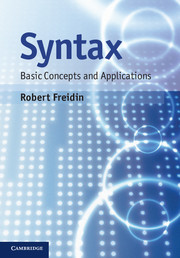Book contents
- Frontmatter
- Contents
- Preface
- Acknowledgements
- 1 The computational nature of human language
- 2 Knowledge of language as an object of inquiry
- 3 Categories and constituents
- 4 Phrase structure theory
- 5 The structure of clauses
- 6 The syntax of Spec-TP
- 7 Head movement and the structure of root clauses
- 8 Wh-movement
- 9 Ellipsis
- Notes
- Glossary
- References
- Index
2 - Knowledge of language as an object of inquiry
Published online by Cambridge University Press: 05 November 2012
- Frontmatter
- Contents
- Preface
- Acknowledgements
- 1 The computational nature of human language
- 2 Knowledge of language as an object of inquiry
- 3 Categories and constituents
- 4 Phrase structure theory
- 5 The structure of clauses
- 6 The syntax of Spec-TP
- 7 Head movement and the structure of root clauses
- 8 Wh-movement
- 9 Ellipsis
- Notes
- Glossary
- References
- Index
Summary
As the English examples that were partially analyzed in the previous chapter have shown, language has a complex computational structure that involves a mapping between the PF representation of a linguistic expression (its sound/pronunciation) and its LF representation, which determines its unique interpretation (roughly its meaning). In some cases there appears to be a one-to-one correspondence of elements in PF and LF – for example, the sentence Fish fish fish. In others, LF will contain covert elements necessary for interpretation, which do not occur in PF. The command Fish fish!, which involves an understood subject “you” at LF, is one such example. The 4-fish example is another.
EXERCISE 2.1
On one interpretation of Fish fishfishfishthe LF representation contains two covert elements, whereas the LF representation of the other interpretation contains only one. Discuss.
In addition, the way in which overt and covert elements are grouped together into syntactic units is also covert information that plays a crucial role in determining the nature of LF representation and thus, by extension, the mapping between PF and LF.
Although linguistic expressions are informally referred to as sentences (e.g. The pianist arrived late) and their constituent parts (e.g. the nominal phrase the pianist or the single noun pianist), it is rather the paired PF and LF representations that fully identify each expression. Their orthographic representation as a linear sequence of written characters, which is a conventional way to represent linguistic expressions, adds no new information and sometimes lacks crucial structural information that distinguishes between distinct PF and/or LF representations (e.g. the 1-fish and 5-fish examples in the previous chapter, which are structurally ambiguous).
Information
- Type
- Chapter
- Information
- SyntaxBasic Concepts and Applications, pp. 16 - 36Publisher: Cambridge University PressPrint publication year: 2012
